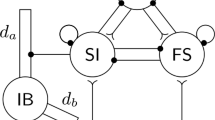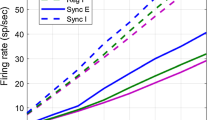Abstract
We study a neural network consisting of model neurons whose efferent synapses are either excitatory or inhibitory. They are densely interconnected on a local scale, but only sparsely on a larger scale. The local clusters are described by the mean activities of excitatory and inhibitory neurons. The equations for these activities define a neuronal oscillator, which can be switched between an active and a passive state by an external input. Investigating the coupling of two of these oscillators we found their coupling behaviour to be activity-dependent. They are tightly coupled and almost synchronized if both oscillators are active, but weakly coupled if one or both oscillators are passive. This activity-dependent coupling is independent of the underlying connectivities, which are fixed. Finally, for coupled active oscillators we derive a simplified description by disregarding the amplitudes of the oscillators and working with their phases. We use this simplified description in a compagnion article to model the oscillations in the visual cortex.
Similar content being viewed by others
References
Baird B (1986) Nonlinear dynamics of pattern formation and pattern recognition in the rabbit olfactory bulb. Physica 22D:150–175
Eckhorn R, Bauer R, Jordan W, Brosch M, Kruse W, Munk M, Reitboeck HJ (1988) Coherent oscillations: a mechanism of feature linking in the visual cortex. Biol Cybern 60:121–130
Edelman GM (1978) In: Edelman GM, Mountcastle VB (eds) The mindful brain. MIT Press, Cambridge, Mass, pp 51–100
Edelman GM (1987) Neural Darwinism. The theory of neuronal group selection. Basic Books, New York
Finkel LH, Edelman GM (1989) Integration of distributed cortical systems by reentry: a computer simulation of interactive functionally segregated visual areas. J Neurosci 9:3188–3208
Freeman WJ (1975) Mass action in the nervous system. Academic Press, New York
Freeman WJ, van Dijk BW (1987) Spatial patterns of visual cortical fast EEG during conditioned reflex in a rhesus monkey. Brain Res 422:267–276
Freeman WJ, Yao Y, Burke B (1988) Central pattern generating in olfactory bulb: A correlation learning rule. Neural Networks 1:277–288.
Gerstein GL, Bedenbaugh P, Aertsen AMHJ (1989) Neuronal assemblies. IEEE Trans Biomed Eng 36:4–14
Gray CM, Singer W (1989) Neuronal oscillations in orientation columns of cat visual cortex. Proc Natl Acad Sci USA 86:1698–1702
Gray CM, König P, Engel AK, Singer W (1989) Oscillatory responses in cat visual cortex exhibit inter-columnar synchronization which reflects global stimulus properties. Nature 338:334–337
Guckenheimer J, Holmes P (1983) Nonlinear oscillations, dynamical systems, and bifurcations of vector fields. Springer, Berlin Heidelberg New York
Hassard B, Wan YH (1978) Bifurcation formulae derived from center manifold theory. J Math Anal Appl 63:297–312.
Hirsch MW, Smale S (1974) Differential equations, dynamical systems and linear algebra. Academic Press, New York
Hopfield JJ (1984) Neurons with graded response have collective properties like those of two-state neurons. Proc Natl Acad Sci USA 81:3088–3092
Kammen DM, Holmes PJ, Koch C (1989) Cortical architecture and oscillations in neuronal networks: feedback versus local coupling. In: Cotterill RMJ (ed) Models of brain function. University Press, Cambridge
Kammen DM, Holmes PJ, Koch C (1990) Origin of synchronized oscillations in visual cortex: global feedback versus local coupling. Proc Natl Acad Sci USA (submitted for publication)
Kandel ER, Schwarz JH (eds) (1985) Principles of neural science 2nd edn. Elsevier, New York Amsterdam Oxford
Kuramoto Y (1984) Chemical oscillations, waves, and turbulence. tSpringer, Berlin Heidelberg New York
Nayfeh AL, Mook DT (1979) Nonlinear oscillations. Wiley, New York
Sakaguchi H, Kuramoto Y (1986) A soluble active rotator model showing phase transitions via mutual entrainment. Prog Theor Phys 76:576–581
Shinomoto S (1987) A cognitive and associative memory. Biol Cybern 57:197–206
Sporns O, Gally JA, Reeke GN, Edelman GM (1989) Reentrant signaling among simulated neuronal groups leads to coherency in their oscillatory activity. Proc Natl Acad Sci USA 86:7265–7269
Wilson HR, Cowan JD (1972) Excitatory and inhibitory interactions in localized populations of model neurons. Biophys J 12:1–24
Winfree AT (1980) The geometry of biological time. Springer, New York Berlin Heidelberg
Author information
Authors and Affiliations
Rights and permissions
About this article
Cite this article
Schuster, H.G., Wagner, P. A model for neuronal oscillations in the visual cortex. Biol. Cybern. 64, 77–82 (1990). https://doi.org/10.1007/BF00203633
Received:
Accepted:
Issue Date:
DOI: https://doi.org/10.1007/BF00203633




